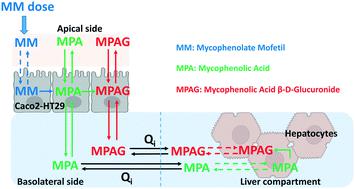Our official English website, www.x-mol.net, welcomes your
feedback! (Note: you will need to create a separate account there.)
Application of a gut–liver-on-a-chip device and mechanistic modelling to the quantitative in vitro pharmacokinetic study of mycophenolate mofetil
Lab on a Chip ( IF 6.1 ) Pub Date : 2022-07-14 , DOI: 10.1039/d2lc00276k Nicoló Milani 1, 2 , Neil Parrott 1 , Daniela Ortiz Franyuti 1 , Patricio Godoy 1 , Aleksandra Galetin 2 , Michael Gertz 1 , Stephen Fowler 1
Lab on a Chip ( IF 6.1 ) Pub Date : 2022-07-14 , DOI: 10.1039/d2lc00276k Nicoló Milani 1, 2 , Neil Parrott 1 , Daniela Ortiz Franyuti 1 , Patricio Godoy 1 , Aleksandra Galetin 2 , Michael Gertz 1 , Stephen Fowler 1
Affiliation

|
Microphysiological systems (MPS) consisting of multiple linked organ-on-a-chip (OoC) components are highly promising tools with potential to provide more relevant in vitro to in vivo translation of drug disposition, efficacy and toxicity. A gut–liver OoC system was employed with Caco2 cells in co-culture with HT29 cells in the intestinal compartment and single donor primary hepatocytes in the hepatic compartment for the investigation of intestinal permeability, metabolism (intestinal and hepatic) and potential interplay of those processes. The prodrug mycophenolate mofetil was tested for quantitative evaluation of the gut–liver OoC due to the contribution of both gut and liver in its metabolism. Conversion of mycophenolate mofetil to active drug mycophenolic acid and further metabolism to a glucuronide metabolite was assessed over time in the gut apical, gut basolateral and liver compartments. Mechanistic modelling of experimental data was performed to estimate clearance and permeability parameters for the prodrug, active drug and glucuronide metabolite. Integration of gut–liver OoC data with in silico modelling allowed investigation of the complex combination of intestinal and hepatic processes, which is not possible with standard single tissue in vitro systems. A comprehensive evaluation of the mechanistic model, including structural model and parameter identifiability and global sensitivity analysis, enabled a robust experimental design and estimation of in vitro pharmacokinetic parameters. We propose that similar methodologies may be applied to other multi-organ microphysiological systems used for drug metabolism studies or wherever quantitative knowledge of changing drug concentration with time enables better understanding of biological effect.
中文翻译:

肠-肝芯片装置和机械模型在吗替麦考酚酯定量体外药代动力学研究中的应用
由多个连接的片上器官 (OoC) 组件组成的微生理系统 (MPS) 是极具前景的工具,有可能在体外和体内提供更多相关性药物处置、功效和毒性的翻译。肠-肝 OoC 系统与 Caco2 细胞共培养,与肠腔中的 HT29 细胞和肝腔中的单一供体原代肝细胞共培养,以研究肠道通透性、代谢(肠道和肝脏)以及这些过程的潜在相互作用. 由于肠道和肝脏在其代谢中的贡献,对前药霉酚酸酯进行了肠道-肝脏 OoC 的定量评估。随着时间的推移,在肠道顶端、肠道基底外侧和肝脏隔室中评估了霉酚酸酯转化为活性药物霉酚酸并进一步代谢为葡萄糖苷酸代谢物。对实验数据进行机械建模以估计前药的清除率和渗透性参数,活性药物和葡萄糖苷酸代谢物。将肠-肝 OoC 数据与计算机建模允许研究肠道和肝脏过程的复杂组合,这对于标准的单组织体外系统是不可能的。对机制模型的综合评估,包括结构模型和参数可识别性以及全局敏感性分析,能够进行稳健的实验设计和体外药代动力学参数的估计。我们建议将类似的方法学应用于其他用于药物代谢研究的多器官微生理系统,或者任何关于药物浓度随时间变化的定量知识能够更好地理解生物效应的地方。
更新日期:2022-07-14
中文翻译:

肠-肝芯片装置和机械模型在吗替麦考酚酯定量体外药代动力学研究中的应用
由多个连接的片上器官 (OoC) 组件组成的微生理系统 (MPS) 是极具前景的工具,有可能在体外和体内提供更多相关性药物处置、功效和毒性的翻译。肠-肝 OoC 系统与 Caco2 细胞共培养,与肠腔中的 HT29 细胞和肝腔中的单一供体原代肝细胞共培养,以研究肠道通透性、代谢(肠道和肝脏)以及这些过程的潜在相互作用. 由于肠道和肝脏在其代谢中的贡献,对前药霉酚酸酯进行了肠道-肝脏 OoC 的定量评估。随着时间的推移,在肠道顶端、肠道基底外侧和肝脏隔室中评估了霉酚酸酯转化为活性药物霉酚酸并进一步代谢为葡萄糖苷酸代谢物。对实验数据进行机械建模以估计前药的清除率和渗透性参数,活性药物和葡萄糖苷酸代谢物。将肠-肝 OoC 数据与计算机建模允许研究肠道和肝脏过程的复杂组合,这对于标准的单组织体外系统是不可能的。对机制模型的综合评估,包括结构模型和参数可识别性以及全局敏感性分析,能够进行稳健的实验设计和体外药代动力学参数的估计。我们建议将类似的方法学应用于其他用于药物代谢研究的多器官微生理系统,或者任何关于药物浓度随时间变化的定量知识能够更好地理解生物效应的地方。











































 京公网安备 11010802027423号
京公网安备 11010802027423号